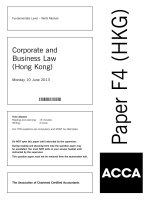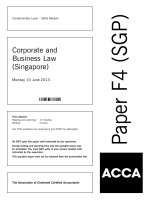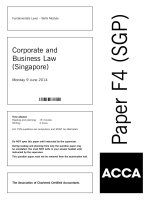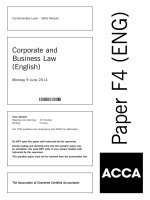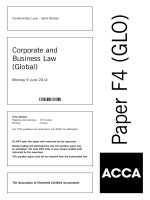ACCA f4 corporate and business law study text for 2011
Bạn đang xem bản rút gọn của tài liệu. Xem và tải ngay bản đầy đủ của tài liệu tại đây (6.28 MB, 481 trang )
1481
www.ebooks2000.blogspot.com
S
T
U
D
Y
PAPER F4
CORPORATE AND BUSINESS LAW
(ENGLISH)
BPP Learning Media is the sole ACCA Platinum Approved Learning Partner – content
for the ACCA qualification. In this, the only Paper F4 (ENG) study text to be reviewed
by the examiner:
•
We discuss the best strategies for studying for ACCA exams
•
We highlight the most important elements in the syllabus and the key skills you will need
•
We signpost how each chapter links to the syllabus and the study guide
•
We provide lots of exam focus points demonstrating what the examiner will want you to do
•
We emphasise key points in regular fast forward summaries
•
We test your knowledge of what you've studied in quick quizzes
•
We examine your understanding in our exam question bank
•
We reference all the important topics in our full index
BPP's i-Pass product also supports this paper.
FOR EXAMS IN 2011
2481
www.ebooks2000.blogspot.com
T
E
X
T
First edition 2007
Fourth edition December 2010
ISBN 9780 7517 8918 8
(Previous ISBN 9870 7517 6364 5)
British Library Cataloguing-in-Publication Data
A catalogue record for this book
is available from the British Library
Published by
BPP Learning Media Ltd
BPP House, Aldine Place
London W12 8AA
All our rights reserved. No part of this publication may be
reproduced, stored in a retrieval system or transmitted, in
any form or by any means, electronic, mechanical,
photocopying, recording or otherwise, without the prior
written permission of BPP Learning Media Ltd.
www.bpp.com/learningmedia
Printed in the United Kingdom
We are grateful to the Association of Chartered Certified
Accountants for permission to reproduce past
examination questions. The suggested solutions in the
exam answer bank have been prepared by BPP Learning
Media Ltd, unless otherwise stated.
Your learning materials, published by BPP
Learning Media Ltd, are printed on paper
sourced from sustainable, managed forests.
©
BPP Learning Media Ltd
2010
ii
3481
www.ebooks2000.blogspot.com
Contents
Page
Introduction
Helping you to pass – the ONLY F4 (ENG) Study Text reviewed by the examiner!
Studying F4
The exam paper
Part A Essential elements of the legal system
1
2
3
The English legal system
Sources of English law
Human rights
Part B The law of obligations
4
5
6
7
8
9
Formation of contracts I
Formation of contracts II
Terms of contract
Breach of contract
The law of torts
Professional negligence
Part C Employment law
10
11
Employment contract
Dismissal and redundancy
Part D The formation and constitution of business organisations
12
13
14
15
Agency law
Organisations and legal personality
Company formation
Constitution of a company
Part E Capital and the financing of companies
16
17
18
Share capital
Borrowing and loan capital
Capital maintenance and dividend law
Part F Management, administration and regulation of companies
19
20
Company directors and other company officers
Company meetings and resolutions
Part G Legal implications of companies in difficulty or in crisis
21
Insolvency and administration
Part H Governance and ethical issues relating to business
22
23
Corporate governance
Fraudulent behaviour
v
vii
x
3
17
35
47
67
87
105
121
135
145
163
183
193
221
237
255
269
283
299
333
351
371
387
Exam question bank
403
Exam answer bank
409
List of cases and index
441
Review form and free prize draw
Contents
4481
www.ebooks2000.blogspot.com
iii
A note about copyright
Dear Customer
What does the little © mean and why does it matter?
Your market-leading BPP books, course materials and elearning materials do not write and update
themselves. People write them: on their own behalf or as employees of an organisation that invests in this
activity. Copyright law protects their livelihoods. It does so by creating rights over the use of the content.
Breach of copyright is a form of theft – as well being a criminal offence in some jurisdictions, it is
potentially a serious breach of professional ethics.
With current technology, things might seem a bit hazy but, basically, without the express permission of
BPP Learning Media:
• Photocopying our materials is a breach of copyright
• Scanning, ripcasting or conversion of our digital materials into different file formats, uploading them
to facebook or emailing them to your friends is a breach of copyright
You can, of course, sell your books, in the form in which you have bought them – once you have finished
with them. (Is this fair to your fellow students? We update for a reason.) But the e-products are sold on a
single user licence basis: we do not supply ‘unlock’ codes to people who have bought them second hand.
And what about outside the UK? BPP Learning Media strives to make our materials available at prices
students can afford by local printing arrangements, pricing policies and partnerships which are clearly
listed on our website. A tiny minority ignore this and indulge in criminal activity by illegally photocopying
our material or supporting organisations that do. If they act illegally and unethically in one area, can you
really trust them?
iv
5481
www.ebooks2000.blogspot.com
Helping you to pass – the ONLY F4 (ENG) Study Text
reviewed by the examiner!
BPP Learning Media – the sole Platinum
Approved Learning Partner - content
As ACCA’s sole Platinum Approved Learning Partner – content, BPP Learning Media gives you the
unique opportunity to use examiner-reviewed study materials for the 2011 exams. By incorporating the
examiner’s comments and suggestions regarding the depth and breadth of syllabus coverage, the BPP
Learning Media Study Text provides excellent, ACCA-approved support for your studies.
The PER alert
Before you can qualify as an ACCA member, you do not only have to pass all your exams but also fulfil a
three year practical experience requirement (PER). To help you to recognise areas of the syllabus that
you might be able to apply in the workplace to achieve different performance objectives, we have
introduced the ‘PER alert’ feature. You will find this feature throughout the Study Text to remind you that
what you are learning to pass your ACCA exams is equally useful to the fulfilment of the PER
requirement.
Tackling studying
Studying can be a daunting prospect, particularly when you have lots of other commitments. The
different features of the text, the purposes of which are explained fully on the Chapter features page, will
help you whilst studying and improve your chances of exam success.
Developing exam awareness
Our Texts are completely focused on helping you pass your exam.
Our advice on Studying F4 outlines the content of the paper, the necessary skills the examiner expects
you to demonstrate and any brought forward knowledge you are expected to have.
Exam focus points are included within the chapters to highlight when and how specific topics were
examined, or how they might be examined in the future.
Using the Syllabus and Study Guide
You can find the syllabus and Study Guide on page (xi) of this Study Text
Testing what you can do
Testing yourself helps you develop the skills you need to pass the exam and also confirms that you can
recall what you have learnt.
We include Questions – lots of them - both within chapters and in the Exam Question Bank, as well as
Quick Quizzes at the end of each chapter to test your knowledge of the chapter content.
Introduction
6481
www.ebooks2000.blogspot.com
v
Chapter features
Each chapter contains a number of helpful features to guide you through each topic.
Topic list
Topic list
Syllabus reference
What you will be studying in this chapter and the relevant
section numbers, together the ACCA syllabus references.
Introduction
Puts the chapter content in the context of the syllabus as
a whole.
Study Guide
Links the chapter content with ACCA guidance.
Exam Guide
Highlights how examinable the chapter content is likely to
be and the ways in which it could be examined.
Knowledge brought forward from earlier studies
What you are assumed to know from previous
studies/exams.
FAST FORWARD
Summarises the content of main chapter headings,
allowing you to preview and review each section easily.
Examples
Demonstrate how to apply key knowledge and
techniques.
Key terms
Definitions of important concepts that can often earn you
easy marks in exams.
Exam focus points
When and how specific topics were examined, or how
they may be examined in the future.
Formula to learn
Formulae that are not given in the exam but which have to
be learnt.
Gives you a useful indication of syllabus areas that
closely relate to performance objectives in your Practical
Experience Requirement (PER).
vi
7481
Question
Gives you essential practice of techniques covered in the
chapter.
Case Study
Real world examples of theories and techniques.
Chapter Roundup
A full list of the Fast Forwards included in the chapter,
providing an easy source of review.
Quick Quiz
A quick test of your knowledge of the main topics in the
chapter.
Exam Question Bank
Found at the back of the Study Text with more
comprehensive chapter questions. Cross referenced for
easy navigation.
Introduction
www.ebooks2000.blogspot.com
Studying F4
This paper examines a basic understanding of legal principles and their application. You may find the
material a little different from what you are used to because there are virtually no numbers involved.
Therefore it is important to develop a concise style of writing in order to get your points across quickly
and clearly.
The F4 examiner
The examiner for this paper is David Kelly and he has been in the role for some time. Therefore there
should be no surprises when it comes to your exam – each of his papers is similar in style and content.
1 What F4 is about
The main aims of the F4 exam are:
•
To develop knowledge and skills in the understanding of the general legal framework and of
specific legal areas relating to business, but
•
To recognise the need to seek further specialist legal advice where necessary
The exam is not designed to turn you into a legal expert. Instead you will be a well-informed professional
accountant who appreciates the legal issues of doing business but who recognises the boundaries of their
legal knowledge and therefore the point at which professional legal expertise must be sought. The
sequence of the syllabus and study guide takes you through the main areas of what you need to know.
Essential elements of the legal system
In this part of the syllabus you are covering areas that underlie all the other areas, namely: what is law and
how the UK legal system creates and administers it. The distinctions between criminal law and civil law,
between common law and civil law and between public law and private law, are very important. Most of
the paper is concerned with civil law, namely the law that sets out the rights and duties of persons in
relation to each other. There are elements of criminal law in relation to companies, insolvency, insider
dealing and money laundering, in addition to the topical area of human rights legislation.
Law of obligations
The syllabus clearly distinguishes two important types of obligation that individuals and businesses have.
Contract
When individuals or businesses make agreements, a legally binding contract may be formed. This paper
focuses on the requirements that must be met for a contract to be binding on the parties, what valid
contracts must contain, under which circumstances the contractual terms are breached and what
remedies are available for the affected party.
Tort
All members of society have a duty not to harm others and this principle forms the basis of tort. The tort
of negligence is highly topical and has an impact on individuals, businesses and professionals (such as
accountants). It is important for you to understand how such a duty is formed, the circumstances that will
cause a breach of that duty and if there are any defences to a breach that the perpetrator can call on.
Employment law
Employees and employers are bound to each other by an employment contact. It is important that you
have a good understanding of the contents of such a contract. Both employers and their employees owe
duties to each other and breach of these duties can result in legal action being taken.
Termination of employment can be fraught with danger for employers if it is not handled correctly. The
terms of 'wrongful' and 'unfair' dismissal are used commonly in the media, but the causes and remedies
are distinct and it is important for you to understand the difference.
Introduction
8481
www.ebooks2000.blogspot.com
vii
Formation and constitution of business organisations
The syllabus is very concerned with the various legal forms through which business transactions may be
conducted. It is important to distinguish initially between natural persons (human beings) and legal
persons (including natural persons, but extending to some forms of partnership and, most significantly,
companies). The law of agency underlies a substantial part of our study of business forms, since partners
and directors can and sometimes do act as agents.
Capital and the financing of companies
Most trading companies are financed by a mix of share capital (provided by their owners) and loan capital
(provided by third party lenders). Share capital may take a variety of forms, with each class of share
having different rights within the company. However, the primary responsibility of the shareholder is to
contribute funds to the company in accordance with the terms of the company’s constitution and the
shares which they own. The return of these funds to shareholders is restricted since they are seen as the
'creditors' buffer', that is the funds which are available to settle creditors' outstanding debts in preference
to amounts due to shareholders. Hence there are detailed laws on 'capital maintenance'. These extend to
how far companies may distribute accumulated retained earnings to their shareholders in the form of
dividends or buyback of shares.
Loan capital is usually provided by lenders only if they can be assured of its repayment to them. If lenders
supply funds in return for debentures in the company, they usually require security for their loan: the
debenture is secured by means of a registered charge on particular or general assets of the company,
which can (within limitations) be realised so that the loan is repaid.
Management, administration and regulation of companies
As an artificial legal person a company cannot manage itself. This is the role primarily of the company's
directors, who owe duties to the company to manage it for the benefit of the company and thereby for the
benefit of its owners, the shareholders. There are a great many legal rules which regulate the appointment,
remuneration, disqualification, powers and duties of directors. These have grown up largely because of
problems that frequently occur. Most of these can be said to arise from conflicts between directors'
personal interests and their duties to act in the company's interest. Directors are termed officers of the
company along with the company secretary. Many companies also have to have an auditor.
Directors come into immediate contact with shareholders via company meetings, and the resolutions that
are passed at these meetings. There are therefore a plethora of legal rules on meetings and resolutions,
designed to ensure that the company is taking decisions properly and in accordance with the legitimate
interests of shareholders as a body.
Legal implications of companies in difficulty or in crisis
Not everything goes according to plan and frequently companies will encounter financial or other
difficulties, or will even reach crisis point and find themselves insolvent. At this point all parties –
shareholders, directors, lenders, customers, suppliers and employees – are in danger of losing out. There
are procedures designed to protect struggling companies to give them a 'breathing space' while they
resolve their issues. There are also rules for how a company which cannot be saved should be 'wound up',
depending on whether or not the company has any funds left.
Corporate governance
Corporate governance means trying to ensure that companies are well-managed and controlled. While
there are plenty of legal rules designed to ensure good corporate governance, there are also voluntary
codes of practice which apply to some but not all companies. The UK Corporate Governance Code applies
to all companies listed on the London Stock Exchange, but is also recommended to other companies. It
seeks to protect shareholders and addresses the problems of conflicts of interest in part by implementing
the principle of separation of duties between executive and non-executive directors. It also covers
directors' remuneration, external audit, nominations to the board of directors and other issues.
viii
9481
Introduction
www.ebooks2000.blogspot.com
Fraudulent behaviour
Finally the syllabus covers the situations where activities of directors and others have strayed into criminal
behaviour. This often arises in the context of companies running out of money, but the law is also
concerned with company insiders with superior knowledge benefiting from insider dealing, and crime in
the form of money laundering.
2 What skills are required?
To pass the F4 exam you will need to bring a number of different professional attributes to bear.
First you need technical knowledge. There is a huge amount of technical content in the syllabus: case law,
conventions, codes of practice, and legislation. You need to learn this and be able to identify which parts
of the knowledge you have are being called for in a particular question.
Secondly you need to be able to apply knowledge to the scenarios that are presented in the last three
questions on the paper. You are aiming to solve practical problems here. Generally in scenario questions
there will be marks available for stating the law, identifying the issues in the scenario in relation to the law,
applying the law and reaching a conclusion.
Thirdly you need written skills in order to be able to explain, and advise on the basis of, your technical
knowledge. Explaining means providing simple definitions and covering why and how these approaches
have been developed. You’ll gain higher marks if your explanations are clearly focused on the question and
you can supplement your explanations with examples.
3 How to improve your chances of passing
To pass the exam you need to cover the syllabus thoroughly. The exam requires you to answer all TEN
questions on the paper. Each topic that you fail to cover represents 10% fewer marks in the exam.
You should practise answering questions as much as possible, making sure that your answers are
focused, specific and completely relevant to the question.
Ten questions is a lot to answer in three hours so your exam technique is very important, especially:
•
Strict time management: only 18 minutes per answer
•
Deciding on the order in which you attempt questions carefully: use your 15 minutes reading and
planning time carefully to make sure that you attempt your best topics first when you start to write.
This will bolster your confidence and help to ensure that you manage your time properly, so long
as you don’t overrun your time allocation on the early, 'better' questions
•
Reading the question carefully: make sure you identify precisely the key issues requiring your
attention
Only answering the question set: do not stray into irrelevant areas of, say, contract law. You will gain no
marks and you will lose time.
Introduction
10481
www.ebooks2000.blogspot.com
ix
The exam paper
Format of the paper
The examination is a three hour paper consisting of seven, ten-mark questions testing knowledge and
three, ten-mark application (scenario) questions.
Guidance
As all questions are compulsory it is vital to attempt all of them. Even if you are not confident about an
area of law, it is often easier to earn marks by starting a question and putting something down, than by
adding material to an already developed answer.
When answering scenario questions follow the ISAC approach
Identify the legal issues
State the relevant law
Apply the law
Conclude
This structure will maximise your marks as you identify what the problem is, state what the law says about
the problem, apply the law and come to a reasonable conclusion – exactly what the examiner wants.
You should quote case names in your answers. Do your best to learn as many as you can (at least a
handful in each topic area), but don't worry if in the exam you forget the case name – as long as you
correctly state the principle of law you will earn most of the marks.
Negligence
The December 2007 exam saw the first tort question under the new syllabus. It required candidates to
explain the concept of 'remoteness of damage'. According to examiner's report on the sitting, the vast
majority of candidates ignored the reference to tort and answered the question on the basis of contract
law. They consequently scored very low marks. When studying please remember that 'remoteness of
damage' under tort and contract are completely unrelated concepts. Do not mix them up in an exam
question.
Company law
Many students have failed this exam because they refer to out-of-date company law. This text is based on
the latest (Companies Act 2006) so you are assured the material you are about to study is up-to-date.
Syllabus and Study Guide
The F4 syllabus and study guide can be found below.
x
11481
Introduction
www.ebooks2000.blogspot.com
Introduction
12481
www.ebooks2000.blogspot.com
xi
xii
13481
Introduction
www.ebooks2000.blogspot.com
Introduction
14481
www.ebooks2000.blogspot.com
xiii
xiv
15481
Introduction
www.ebooks2000.blogspot.com
Introduction
16481
www.ebooks2000.blogspot.com
xv
xvi
17481
Introduction
www.ebooks2000.blogspot.com
Analysis of past papers
The table below provides details of when each element of the syllabus has been examined and the
question number and section in which each element appeared. Further details can be found in the Exam
Focus Points in the relevant chapters.
Covered
in Text
chapter
June
2010
Dec
2009
June
2009
Dec
2008
June
2008
Dec
2007
Pilot
Pape
r
ESSENTIAL ELEMENTS OF THE LEGAL SYSTEM
1
The English legal system
2
Sources of English law
3
Human rights
1
1
1
1
1
1
2
2
8
2
8
3
3
8
1
THE LAW OF OBLIGATIONS
4, 5
Formation of contracts
6
Terms of contract
7
Breach of contract
8
Torts
9
Professional negligence
2, 8
3
2, 8
8
2
2
8
3
3
3
3
6
7
4
EMPLOYMENT LAW
10
Employment contract
11
Dismissal and redundancy
7
7
7
7
7
THE FORMATION AND CONSTITUTION OF
BUSINESS ORGANISATIONS
12
Agency law
10
13
Organisations and legal personality
9
14
Company formation
4
15
Constitution of a company
5
4,10
4, 9, 10
4
4
9
4
CAPITAL AND THE FINANCING OF COMPANIES
16
Share capital
10
17
Borrowing and loan capital
5
18
Capital maintenance and dividend law
4
5
9
5
9
5
9
5
MANAGEMENT, ADMINISTRATION AND
REGULATION OF COMPANIES
19
Company directors and other company officers
20
Company meetings and resolutions
6, 10
9
6, 9
6
6
7, 10
5
5
LEGAL IMPLICATIONS OF COMPANIES IN
DIFFICULTY OR IN CRISIS
21
Insolvency and administration
6
GOVERNANCE AND ETHICAL ISSUES RELATING
TO BUSINESS
22
Corporate governance
23
Fraudulent behaviour
6
10
10
10
10
Introduction
18481
www.ebooks2000.blogspot.com
xvii
xviii
19481
Introduction
www.ebooks2000.blogspot.com
P
A
R
T
A
Essential elements of the legal
system
1
20481
www.ebooks2000.blogspot.com
2
21481
www.ebooks2000.blogspot.com
The English
legal system
Topic list
Syllabus reference
1 What is law?
A1(a)
2 Types of law
A1(a)
3 The system of courts
A1(b)
4 Tribunals
A1(b)
Introduction
Welcome to your study of Corporate and Business law. In this chapter we set
the scene and framework of the English Legal System.
We start by defining what law is and why it is important to society. Our study
continues by considering the different types of law that we have in the UK and
how they have developed over time.
The chapter concludes with an analysis of the Criminal and Civil court
systems. Tribunals are also discussed as an alternative method of dispute
resolution.
Yes, this is F4 paper if you want to get free study material of CAT,
ACCA, CIMA, CFA, CIA visit : freefor911.wordpress.com
3
22481
www.ebooks2000.blogspot.com
Study guide
Intellectual level
A
Essential elements of the legal system
1
Court structure
(a)
Define law and distinguish types of law
1
(b)
Explain the structure and operation of the courts and tribunals system
1
Exam guide
The nature of law and the operation of the legal system form a basis for your later studies but could also
be examined as a topic all by itself.
1 What is law?
FAST FORWARD
'Law is a formal mechanism of social control', Business Law 5th Edition, David Kelly, Ann Holmes and
Ruth Hayward
Human society has developed over thousands of years from a primitive culture where the very survival of
the species was at stake to the complex, diverse and dominating species that humans are today.
Much of the success of this development can be attributable to rules and regulations laid down by
society. With a little further study the need for such rules becomes clear. In the early days of human
existence, survival was achieved by working as a group. There was a fine line between life and death, for
example the stealing of food from another group member could eventually result in starvation or death of
the victim.
Social order, created by rules is at the foundation of the society that we see today. The framework that
was created influences how individuals interact and how businesses operate. In other words, it provides
social control.
The framework of social control can be viewed as having two aspects:
•
•
Formal control mechanisms
Informal control mechanisms
Law is a formal control mechanism. It provides a structure for dealing with and resolving disputes that
may arise, as well as providing some deterrent to those wishing to disrupt social order.
Informal mechanisms include ethical and moral guidance. These are 'norms' or behavioural expectations
that society has developed over time through its culture. Such mechanisms have little formal structure to
organise, control or to punish – such matters are dealt with informally by pressure from other individuals
or groups.
PER 2 requires you to ensure compliance with legal, regulatory and social requirements in your area of
responsibility. The contents of this Study Text should help you identify common legal and regulatory
requirements.
2 Types of law
The English legal system distinguishes several different types of law.
•
•
•
•
4
23481
Common law and equity
Statute law
Private law and public law
Criminal law and civil law
1: The English legal system ⏐ Part A Essential elements of the legal system
www.ebooks2000.blogspot.com
2.1 Common law and equity
The earliest element of the English legal system is common law, a system of rigid rules laid down by royal
courts following the Norman conquest. Application of law was by judges who travelled around the country
to keep the King's peace and judgements often resulted in harsh consequences.
The judges actually made the law by amalgamating local customary laws into one 'law of the land'.
Remedies under common law are monetary, and are known as damages.
However, there are times when money is not a suitable remedy. For example, you have agreed to buy a
unique painting from an art dealer. Should the dealer at the last minute sell the painting to someone else,
damages are unlikely to be acceptable, after all you wanted that painting.
Equity was developed two or three hundred years after common law as a system to resolve disputes
where damages are not a suitable remedy and to introduce fairness into the legal system.
2.2 Statute law
Whilst the judiciary is responsible for the creation of common law, Parliament is responsible for statute
law. Statute law is usually made in areas so complicated or unique that suitable common law alternatives
are unlikely, or would take an unacceptable length of time, to develop – company law is one example of
this.
2.3 Private law and public law
Most of the law that you will be studying is private law. That is law which deals with relationships and
interactions between businesses, and private individuals, groups or organisations.
The state provides a framework for dealing with disputes and for enforcing decisions, but it is for
individuals to handle matters between themselves. For example, the Sale of Goods Act 1979 regulates the
sale of goods. It provides rules that must be adhered to when making a sale. Should any dispute arise that
is covered by the act, it is up to the parties to resolve the matter themselves using rules laid down by the
legislation, the state does not get involved.
Public law is mainly concerned with government and the operation and functions of public organisations
such as councils and local authorities. It will not be of great interest to you in your studies of corporate
law, however examples of public law can be found in planning rules that must be adhered to when
building or expanding offices.
A key distinction between public and private law is who takes up the case when a wrong is committed.
The state prosecutes the alleged perpetrator under public law, whereas we have already seen, under
private law it is for the individual concerned to take action.
Criminal law is a part of public law and deals with behaviour that the state considers unwelcome and
wishes to prevent. Criminal law also decides how those guilty of committing unlawful behaviour should be
punished. You will notice the names of criminal cases are reported as R v Jones or Regina v Jones. This
indicates that the state takes action on behalf of the crown (Regina is Latin for Queen).
2.4 Criminal and civil law
FAST FORWARD
12/07
The distinction between criminal liability and civil liability is central to the English legal system.
It is often the criminal law about which the general public has a clearer perception and keener interest.
Some of the high profile criminal cases at London's Old Bailey are deemed extremely newsworthy. Civil
law, on the other hand, receives less overt media coverage. However, every time you buy or sell goods, or
start or finish an employment contract, your actions, and those of the other party, are governed by civil
law.
The distinction between criminal and civil liability is central to the English legal system and to the way the
court system is structured.
Part A Essential elements of the legal system ⏐ 1: The English legal system
24481
www.ebooks2000.blogspot.com
5
2.4.1 Criminal law
FAST FORWARD
Key term
In criminal cases, the state prosecutes the wrongdoer.
A crime is conduct prohibited by the law.
In a criminal case the State is the prosecutor because it is the community as a whole which suffers as a
result of the law being broken. Persons guilty of crime may be punished by fines payable to the State,
imprisonment, or a community-based punishment.
Generally, the police take the initial decision to prosecute, but this is then reviewed by the Crown
Prosecution Service. Some prosecutions are started by the Director of Public Prosecutions, who is the
head of the Crown Prosecution Service.
In a criminal trial, the burden of proof to convict the accused rests with the prosecution, which must
prove its case beyond reasonable doubt.
2.4.2 Civil law
FAST FORWARD
Civil law exists to regulate disputes over the rights and obligations of persons dealing with each other and
seeks to compensate injured parties.
Civil law is a form of private law. In civil proceedings, the case must be proved on the balance of
probability. The claimant must convince the court that it is more probable than not that their assertions
are true.
There is no concept of punishment, and compensation is paid to the wronged person. Both parties may
choose to settle the dispute out of court should they wish.
Terminology in civil cases is different to that of criminal cases. A claimant sues a defendant. A civil case
would therefore be referred to as, for example, Smith v Megacorp plc.
One of the most important areas of civil liability for business, and accountants in particular, is the law of
contract. The law of contract is looked at in detail in Part B of this text.
2.4.3 Distinction between criminal and civil cases
It is not an act or event which creates the distinction, but the legal consequences. A single event might
give rise to criminal and civil proceedings.
Illustration
A broken leg caused to a pedestrian by a drunken driver is a single event which may give rise to:
•
•
Criminal case (prosecution by the State for the offence of driving with excess alcohol), and
Civil case (the pedestrian sues for compensation for pain and suffering).
The two types of proceedings can be easily distinguished because three vital factors are different:
•
•
•
6
25481
The courts where the case is heard
The procedures
The terminology
1: The English legal system ⏐ Part A Essential elements of the legal system
www.ebooks2000.blogspot.com

